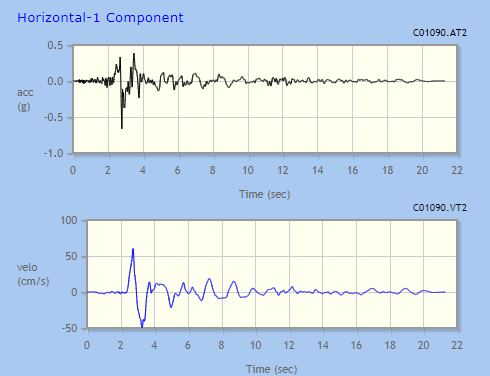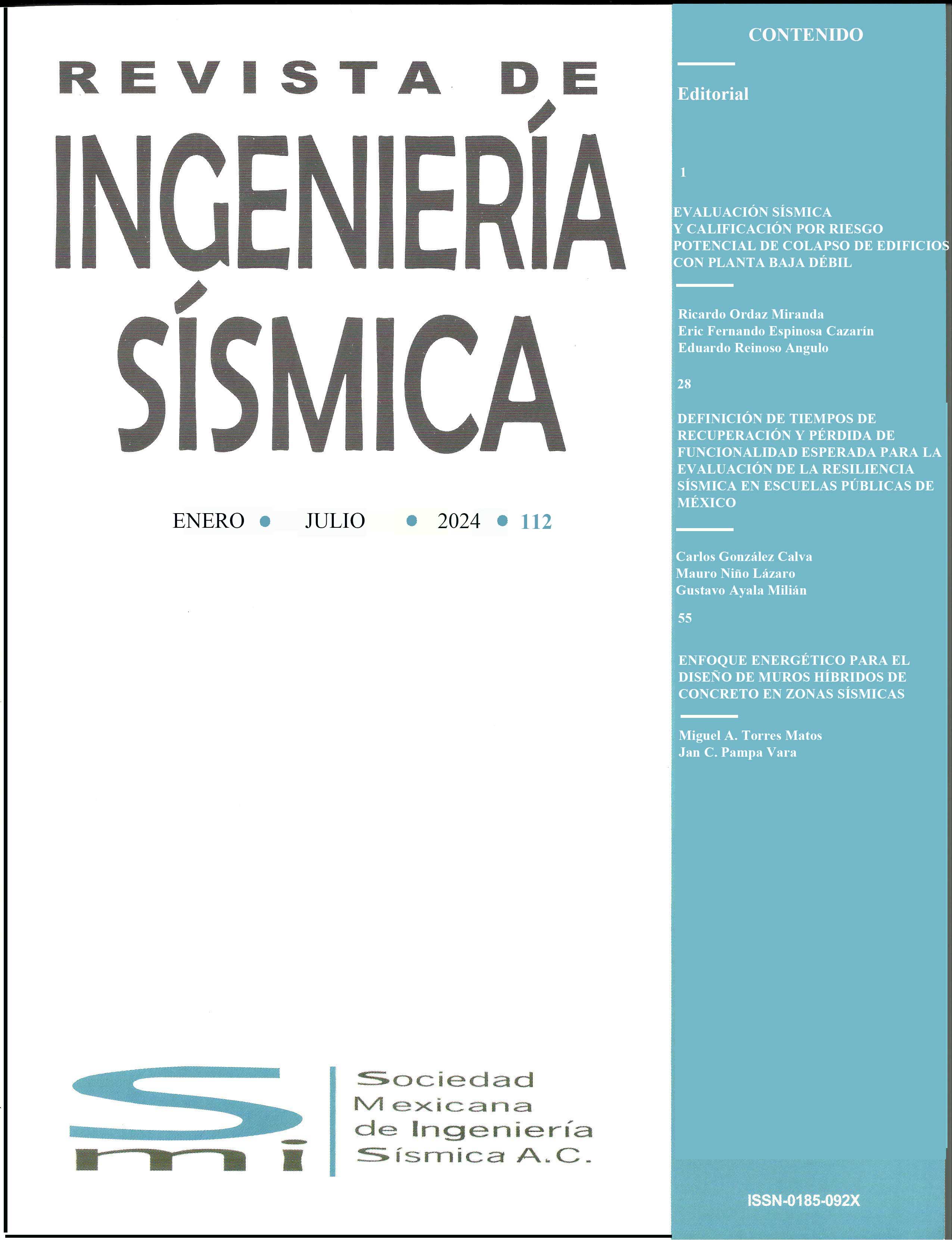PROCEDIMIENTO PARA SELECCIÓN DE ACELEROGRAMAS PARA ESTUDIOS DE FRAGILIDAD EN PUENTES TÍPICOS DE ARGENTINA
DOI:
https://doi.org/10.18867/ris.106.553Palabras clave:
acelerogramas, fragilidad, puentes, ArgentinaResumen
Los acelerogramas adoptados para realizar estudios de fragilidad en puentes a través de análisis dinámico no lineal son uno de los componentes de mayor influencia en los resultados obtenidos. El objetivo de este trabajo es presentar una metodología para selección y escalado de acelerogramas reales de sismos registrados en distintas partes del mundo en ambientes tectónicos semejantes a los del centro-oeste argentino, de manera tal de contar con series de registros compatibles con espectros para distintas clases de sitio, zonas de peligrosidad sísmica y niveles de amenaza sísmica. Para ello, se hizo uso de la aplicación web de la base de datos de movimientos sísmicos del PEER (Pacific Earthquake Engineering Research Center’s). Se tomaron en consideración los espectros objetivos y distintos parámetros, tales como: magnitud del sismo, tipo de falla, distancia de la estructura a la falla, velocidad media de la onda de corte en los 30 metros superiores del terreno, etc. Mediante la aplicación de un criterio novedoso, en el cual se contempla la Intensidad de Aceleración Espectral (ASI), se arribó a 16 series de sismos considerando: 4 clases de sitio, zonas de elevada y muy peligrosidad sísmica del territorio nacional y periodos de recurrencia de 500 y 2500 años. Estas series de registros representativas de la sismicidad de la región referida podrán utilizarse luego para obtener curvas de fragilidad de mayor confiabilidad para distintas clases de puentes típicos.
Descargas
Citas
AASHTO (2011), AASHTO Guide Specifications for LRFD Seismic Bridge Design, American Association of State Highway and Transportation Officials, Washington, DC, 2011.
AASHTO (2018), AASHTO LRFD Bridge Design Specifications, American Association of State Highway and Transportation Officials, Washington, DC.
Aguiar Falconi, R (2004), “Espectros sismicos de riesgo uniforme para verificar desempeño estructural en paises sudamericanos”, Boletin Tecnico Universidad Central de Venezuela, pp. 184-186.
ASCE/SEI 7-10 (2010), Minimum Design Loads for Buildings and Other Structures. ASCE/SEI 7-10, American Society of Civil Engineers, Reston, Virginia.
Atkinson G M (2009), “Earthquake Time Histories Compatible with the 2005 NBCC Uniform Hazard Spectrum”, N6A 5B7, Dept. Earth Sciences, Univ. of Western Ontario, Canada.
Avsar O (2009), “Fragility Based Seismic Vulnerability Assessment of Ordinary Highway Bridges in Turkey”, PhD Thesis, Middle East Technical University. Ankara, Turquía.
Baker J W (2010), “Conditional mean spectrum: Tool for ground-motion selection”, J. Struct. Eng., Vol. 137, pp. 322–331. DOI: 10.1061/(ASCE)ST.1943-541X.0000215
Baker J W, T Lin, S K Shahi, N Jayaram (2011), “New Ground Motion Selection Procedures and Selected Motions for the PEER Transportation Research Program”, PEER Report 2011/03. Pacific Earthquake Engineering Research Center.
Bommer J J y A B Acevedo (2004), “The Use of Real Earthquake Accelerograms as Input to Dynamic Analysis”, Journal of Earthquake Engineering, Volume 8, Special Issue 1, pp. 43-92. DOI: 10.1080/13632460409350521
Buckle, I, I Friedland, J Mander, G Martin, Nutt, R y M Power (2006), Seismic Retrofitting Manual for Highway Structures: Part 1 – Bridges, Office of Infrastructure Research and Development Federal Highway Administration. Washington DC, USA.
Castano, J C (1992) “Influencia de las fuentes sísmicas potenciales en el diseño sismorresistente”. INPRES Publicacion técnica Nº 17, pp. 1-20, Instituto Nacional de Prevención Sísmica, San Juan, Argentina.
Cardona O, A Barbat, M Carreño, G Bernal, M Mora, C Velásquez, M Salgado (2016), Perfil de Riesgo de Desastres. Informe Nacional para Argentina, CIMNE, Centro Internacional de Métodos numéricos en Ingeniería. Banco Interamericano de Desarrollo.
Chiou, B S J y R R Youngs (2008), “Chiou-Youngs NGA ground motion relations for the geometric mean horizontal component of peak and spectral ground motion parameters”, Earthq. Spectra, Vol. 24, pp. 173–215. DOI: 10.1193/1.2894832
Dhakal R P, J B Mander y N Mashiko (2006), “Identification of Critical Ground Motions for Seismic Performance Assessment of Structures”, Earthquake Engineering and Structural Dynamics, Vol. 35, pp. 989-1008. DOI: 10.1002/eqe.568
Elnashai A S, B Borzi y S Vlachos (2004), “Deformation–Based Vulnerability Functions for RC Bridges”, Structural Engineering and Mechanics, Volume 17, No. 2, pp. 215-244. DOI: 10.12989/sem.2004.17.2.215
FEMA 356 (2000), Prestandard and Commentary for the Seismic Rehabilitation of Buildings, FEMA-356, Federal Emergency Management Agency, Washington, DC, 2000.
FEMA P-751 (2012), 2009 NEHRP Recommended Seismic Provisions: Design Examples, FEMA P-751, National Institute of Building Sciences Building Seismic Safety Council. Federal Emergency Management Agency of the Department of Homeland Security, Washington DC.
FEMA P-58-1(2018), Seismic Performance Assessment of Buildings. Volume 1 – Methodology, FEMA P-58-1, Second Edition. Applied Technology Council, Federal Emergency Management Agency.
Frau C y R Saragoni (2005), “Demanda sísmica de fuente cercana. Situación del oeste argentino”, Congreso Chileno de Sismología e Ingeniería Antisísmica, IX Jornadas, Concepción, Chile.
Huang D, W Du, H Zhu (2017), “A procedure to select ground-motion time histories for deterministic seismic hazard analysis from the Next Generation Attenuation (NGA) database”, Natural Hazards and Earth System Sciences, Vol. 17, pp. 1725–1739. DOI: 10.5194/nhess-17-1725-2017
Huff, T (2016) “Issues in the Prediction of Inelastic Behavior in Bridges during Earthquakes”, Practice Periodical on Structural Design and Construction, Volume 21, Issue 3, pp. 13-19. DOI: 10.1061/(ASCE)SC.1943-5576.0000289
INPRES CIRSOC 103 (2018), Reglamento Argentino para Construcciones Sismorresistentes. Parte I. Construcciones en General, Reglamento INPRES CIRSOC 103, Instituto Nacional de Prevención Sísmica, Instituto Nacional de Tecnología Industrial, Argentina.
INPRES-CIRSOC 103 (2019), Proyecto de Reglamento Argentino para Construcciones Sismorresistentes. Parte VI. Puentes de Hormigón Armado, Reglamento INPRES CIRSOC 103, Instituto Nacional de Prevención Sísmica, Instituto Nacional de Tecnología Industrial, Argentina.
Jayaram N, T Lin y J Baker (2011), “A computationally efficient ground-motion selection algorithm for matching a target response spectrum mean and variance”, Earthq. Spectra, Vol. 27, pp. 797– 815. DOI: 10.1193/1.3608002
Kempton J J y J P Stewart (2006), “Prediction equations for significant duration of earthquake ground motions considering site and near-source effects”, Earthquake Spectra, Vol. 22, No. 4, pp. 985-1013. DOI: 10.1193/1.2358175
Kwon O S y A S Elnashai (2006), “The Effect of Material and Ground Motion Uncertainty on the Seismic Vulnerability Curves of RC Structure”, Engineering Structures, Volume 28, pp. 289–303. DOI: 10.1016/j.engstruct.2005.07.010
Luco N y C Cornell (2007), “Structure-specific scalar intensity measures for near-source and ordinary earthquake ground motions”, Earthq. Spectra, Vol. 23, pp. 357–392. DOI: 10.1193/1.2723158
Naeim F y M Lew (1995), “On the use of Design Spectrum Compatible Time Histories”, Earthquake Spectra, Volume 11, No. 1, pp. 111-127. DOI: 10.1193/1.1585805
NEHRP Consultants Joint Venture (2011), Selecting and Scaling Earthquake Ground Motions for Performing Response History Analysis, NIST GCR 11-917-15, National Institute of Standards and Technology, Gaithersburg, Maryland.
Nielson B G (2005), “Analytical Fragility Curves for Highway Bridges in Moderate Seismic Zones”, PhD Thesis, Georgia Institute of Technology. Atlanta, Georgia.
Padgett J E y R DesRoches (2007), “Sensitivity of Seismic Response and Fragility to Parameter Uncertainty”, ASCE Journal of Structural Engineering, Volume 133, No. 12, pp. 1710-1718. DOI: 10.1061/(ASCE)0733-9445(2007)133:12(1710)
PEER (2010a), Users Manual for the PEER Ground Motion Database Web Application. Beta version, PEER, Pacific Earthquake Engineering Research Center, University of California, Berkeley.
PEER (2010b), Technical Report for the PEER Ground Motion Database Web Application. Beta version, PEER, Pacific Earthquake Engineering Research Center, University of California, Berkeley.
Priestley M J N, G M Calvi y M J Kowalsky (2007), Displacement-Based Seismic Design of Structures, IUSS Press Istituto Universitario di Studi Superiori di Pavia, Pavia, Italy.
Rix G J y J A Fernandez-Leon (2004), “Synthetic Ground Motions for Memphis, TN” http://www.ce.gatech.edu/research/mae ground motion.
SAC (1997), “Develop Suite of Time Histories – SAC Venture Steel Project Phase 2 Task 5.4.1”, http://nisee.berkeley.edu/data/strong_motion/sacsteel/draftreport.html.
Saracho J, G Perez, J Barlek, O Dip, E Castelli (2016), “Clasificación de puentes en Argentina para la evaluación de su vulnerabilidad sísmica”, Tecnología y Ciencia, Año 14, No. 28, pp. 25-37.
Saracho J, G Perez, J Barlek, O Dip, E Castelli (2019), “Evaluación de la vulnerabilidad sísmica de puentes típicos en Argentina a través de análisis dinámico no lineal”, Hormigón y Acero, Vol. 70, No. 288, pp. 57-75. DOI: 10.33586/hya.2019.003
Wang G (2011), “A ground motion selection and modification method capturing response spectrum characteristics and variability of scenario earthquakes”, Soil Dyn. Earthq. Eng., Vol. 31, pp. 611–625, 2011. DOI: 10.1016/j.soildyn.2010.11.007
Wang G, R Youngs, M Power y Z Li (2015), “Design ground motion library: an interactive tool for selecting earthquake ground motions”, Earthq. Spectra, Vol. 31, pp. 617–635. DOI: 10.1193/090612EQS283M
Wen Y K. y C L Wu (2001), “Uniform Hazard Ground Motions for Mid-America Cities”, Earthquake Spectra, Vol. 17(2), pp. 359–384. DOI: 10.1193/1.1586179







